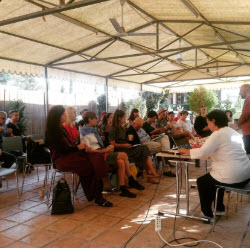Regional Convenings
October 26, 2019
Discussion in the context of the Buffer Fringe Performing Arts Festival
Ledra Palace Buffer Zone, Nicosia
 By Ellada Evangelou
By Ellada Evangelou
The Buffer Fringe Festival hosted a discussion with the participation of artists, community workers, arts practitioners, academics and policy-makers, to discuss what makes arts in community relevant, necessary and challenging. The discussion took place in the Ledra Palace buffer zone, between the two sides of the separated communities of the island. The format was "Long Table" which enabled the engagement of the audience along with the speakers in a semi-formal "brunch table" setting.
The discussion related issues of arts and community, starting from the local and moving to the global, thinking about innovation and the avant garde, discussing about interactions and participation, and how we can connect as artists and community workers. A number of speakers joined us to answer the key questions and start the discussion:
Nurtane Karagil (fine artist — Cyprus), Dijana Milosevic (theatre artist & artistic director — Serbia), Helene Black (curator — artist, Cyprus), Yiannis Colakides (curator — author, Cyprus), Hanna Knell (artistic director, Germany), Lee Perlman, PhD (author — researcher, Israel), Elena Agathokleous (actress — artistic director, Cyprus), Izel Seylani (actor — artistic director, Cyprus). Actor and activist Diomedes Koufteros moderated the session.
The event was organized by Buffer Fringe Artistic Director, and IMPACT Leadership Circle member, Ellada Evangelou.
The discussion generated creative thinking around the relationship between arts and community with a focus on the Cypriot context and ways that the arts can engage communities to be active agents of societal transformation. The role of the buffer zone and other in-between spaces were considered in the discussion along with the role that arts can play in creating community engagement and how it can be understood as a form of living.
"The Buffer Fringe was an extraordinary example of community and artist based conflict transformation, in action. It was an inspiring event on so many levels: first and foremost artistically. Experiencing diverse performance art, other performance forms and installations within and outside of the Buffer Zone, created by local artists and others from the region, including Lebanon and Israel, was remarkable, but also jarring, amid the UN patrolled area. I was also really taken by the spirit of collaboration and broad circles of participation of artists, activists, university students and other young people, festival volunteers, from North and South. As part of the long-table, it was a privilege to learn more the local artists-activists and scholars perspectives on their work and along with my IMPACT colleague, Dijana, frame a conversation about the potential- role of regional or global networks in 'arts and community' practices." — Lee Perlman, PhD, author, researcher (Israel)
"I came back from the Buffer Fringe Festival being very moved and inspired. The space where the Festival took place was, beside few venues, very much "in the buffer zone, just in between the borders that divide Nicosia in two parts —Turkish and Greek. The effect of such placement of the Festival was the sense of connectedness, even surrounded by wires and check points. Many visual art installations, small performances, movie screenings, concerts, open mic stage, exhibitions, exploring the topic of the "buffer zone" and of "the other" offered the space for meeting, expressing different viewpoints in the safe surroundings. It was the celebration of the power of art in healing the society, giving the possibility of exploring untold histories, the stories that were not heard, and generating ideas about how, in the future, to move on from the space of pain." — Dijana Milosevic (theatre artist and artistic director, Serbia)
January 10, 2020
By Christine Vertucci
Between May-August 2019, the Mindanao Peacebuilding Institute (MPI) convened a series of meetings of cultural workers and peacebuilder in Mindanao, Philippines to discuss IMPACT (Imaging Together A Platform for Arts, Culture and Conflict Transformation) and their engagement in this ecosystem. Babu Ayindo, an arts and peacebuilding practitioner and IMPACT Steering Committee member co-facilitated the first meeting on May 25 together with Christine Vertucci, the director of MPI and one of the participants of IMPACT Design Lab.
Participants shared about their work in the performing arts and the challenges they have faced over the years; how they have used arts and storytelling to process trauma and the need for a platform for artists and peacebuilders to come together. A participant who is an indigenous person spoke about how she uses theater to engage young people in her community to understand and appreciate their own culture. Another participant who is a teacher believes that through the performing arts, young people not only become aware of their own culture, but also are able to explore ways to inform the world about Mindanao culture.
In July, MPI hosted the second meeting of South East Asia regional hub with cultural workers and peacebuilding practitioners (both those who attended the first meeting and new participants). Out of this meeting came a proposal to have an Arts and Peacebuilding Training for 15 to 20 young artists in the Davao City area. Its objectives were defined as: 1) to engage youth in creative activities as a way to raise their awareness about social issues and provide entry points to lead them to work for social change/justice through art forms that are attractive to this generation of young people; and 2) to provide a venue for the older generation of cultural workers/artists/performers/cultural activists, who are no longer engaged in groups and/or collectives, to re-engage with each other. The output of this training was to be a theatrical production to be presented at the end of 2019 during the Mindanao Week of Peace.
Work on planning and conceptualizing the training program continued through July and August under the coordination of MPI but it has not yet materialized. The plan is still in the agenda of MPI and the South-East Asia regional hub and waits for the right moment to be carried on.